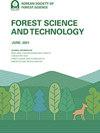Remote sensing based forest canopy opening and their spatial representation
IF 2.2
Q2 FORESTRY
引用次数: 0
Abstract
Abstract The use of remote sensing in natural resource management is an easily accessible input for obtaining detailed information on the ground and landscape. There is a wide range of procedures to analyze the forest canopy through satellite images. The purpose of this work is to obtain a map of forest opening with remote sensing by relating several vegetation indices, Kauth-Thomas transformation and texture filters, to a Landsat 8OLI image. A factor analysis was made to evaluate the contribution of these variable to identify the opening of the forest cover, yielding a σ2 = 76%. The results show that the Modified Soil Adjusted Vegetation Index (MSAVI), Soil Adjusted Vegetation Index (SAVI), and brightness factor have the best correlation (0.225–0.216 component coefficient). The resulting model was reclassified into five categories of forest opening and associated with land use data from the National Institute of Statistics and Geography (INEGI-México). Thus, 95% of human settlements have a canopy opening between medium and very high, the crops areas 72%, and the low deciduous forest with secondary shrub vegetation 100% of the opening. Coniferous and mixed forests have a low to very low canopy opening 46% and 55%, respectively of their surface. The forests with secondary vegetation, both shrub and arboreal, present greater openness than the same forests in the primary state. Verification of the spatial representation data of canopy opening was made by comparing 94 hemispheric photographs with 94 sites located in open areas obtaining an r = 0.57. This work offers a simple and straightforward methodology, easily replicable in different types of vegetation using free satellite imagery. Hence, it is a helpful tool for decision-makers when considering the general status of conservation of forest systems and their spatial distribution.基于遥感的森林冠层开度及其空间表征
遥感在自然资源管理中的应用是获取地面和景观详细信息的一种容易获取的输入方式。通过卫星图像分析森林冠层有多种方法。这项工作的目的是通过将几个植被指数、考特-托马斯变换和纹理滤波器与Landsat 8OLI图像相关联,获得遥感森林开放地图。通过因子分析评价这些变量对森林覆盖度的贡献度,得到σ2 = 76%。结果表明:改良土壤调整植被指数(MSAVI)、土壤调整植被指数(SAVI)与亮度因子的相关系数为0.225 ~ 0.216;由此产生的模型被重新分类为五类森林开放,并与国家统计和地理研究所(inei - m xico)的土地利用数据相关联。因此,95%的人类住区的冠层开度在中等和很高之间,作物区占72%,低落叶次生灌木植被占100%。针叶林和混交林的冠层开度低至极低,分别占地表的46%和55%。具有次生植被的森林(灌木和乔木)比处于原始状态的森林表现出更大的开放性。通过94张半球照片与94个开放区域的站点对比,验证了冠层开口的空间表征数据,得到r = 0.57。这项工作提供了一种简单直接的方法,可以使用免费卫星图像在不同类型的植被中轻松复制。因此,它是决策者在考虑森林系统保护的总体状况及其空间分布时的有用工具。
本文章由计算机程序翻译,如有差异,请以英文原文为准。
求助全文
约1分钟内获得全文
求助全文

 求助内容:
求助内容: 应助结果提醒方式:
应助结果提醒方式:


